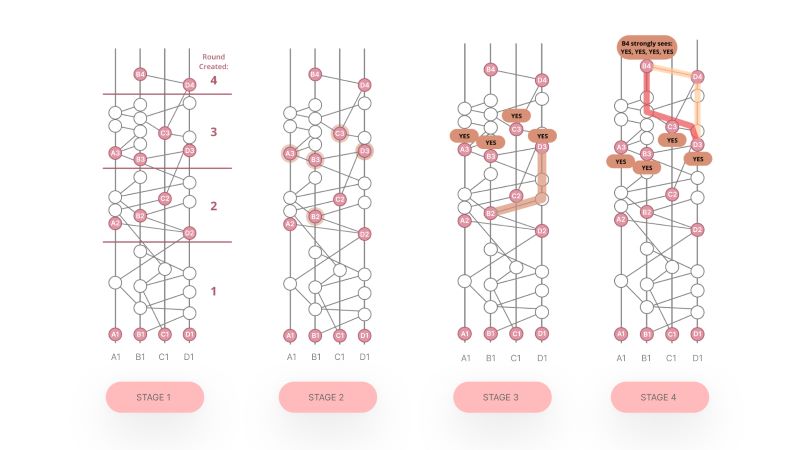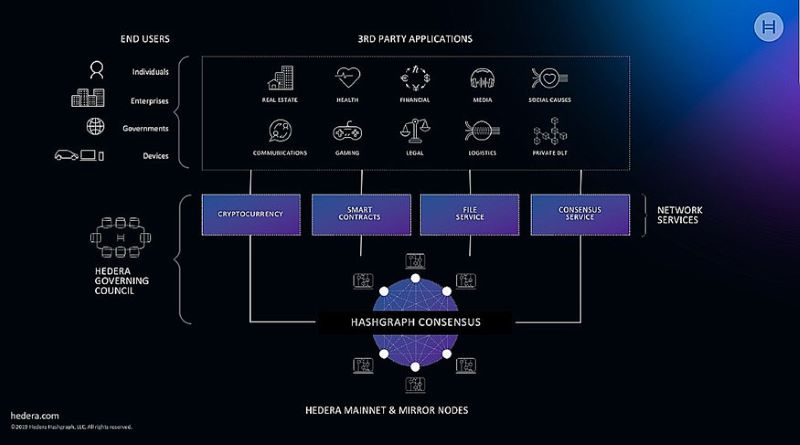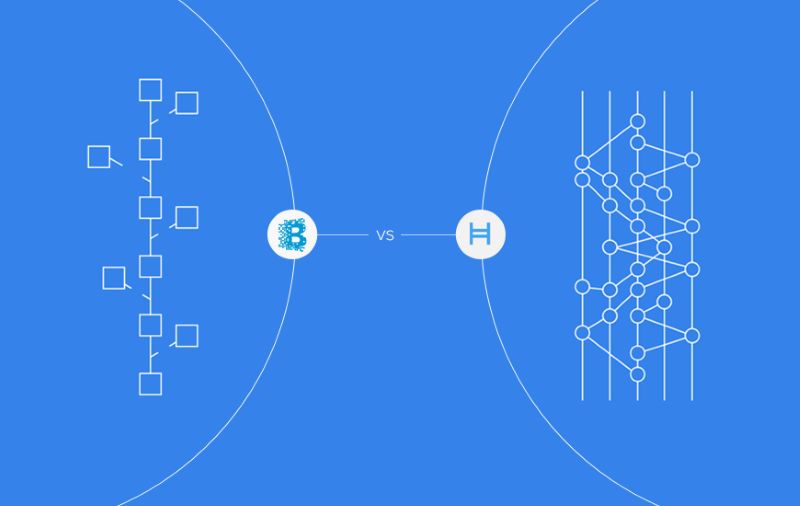Hashgraph Consensus Demystified: Unlocking Blockchain’s Future Potential
Guess what? Blockchain has a sibling that’s raring to go! If you’re still pondering what is hashgraph consensus in blockchain, you’re not alone. But stick with me; I’m about to make it crystal clear. Imagine a world where transactions zip by at lightning speeds under the watchful eyes of supreme security. That’s the realm hashgraph promises to us. It steps up the game where Bitcoin and pals left room. Let’s slice through the tech-speak and see how this fresh player could shape our digital tomorrow.
Understanding Hashgraph: A Primer on Distributed Consensus
The Foundation of Hashgraph Technology
Hashgraph technology is like a new family member in the world of DLT. Unlike blockchain, it’s not built in a line, where one block follows another. Instead, think of it as a web, woven with many paths but no set pattern. This network is called a DAG, short for directed acyclic graph. It’s a fancy way of saying that it flows in one direction and doesn’t loop back.
In simple terms, hashgraph keeps track of who-knows-what and when using something called the Gossip about Gossip protocol. Imagine kids in a schoolyard sharing whispers. Each kid knows who told them the news, and the news spreads like wildfire. This is how hashgraph works. All members talk to each other. They all end up knowing the entire story without everyone needing to chat with one another. This process makes it super fast.
The magic is in the virtual voting. Remember those kids whispering? They don’t need to raise hands to make a decision. They quickly decide based on the gossips they heard. Hashgraph does something similar. Each message contains a bit of history, which lets every member figure out what the group would vote for. It’s like having the power to read minds!
Hashgraph not only sends messages quickly. It also knows the right order for these messages, using fair ordering. Imagine lining up for ice cream in the exact order everyone arrived. Hashgraph makes sure each transaction is like that; nobody cuts in line.
With all these, it claims to process things super fast, way faster than many blockchains. We’re talking thousands of transactions in just a second. But speed isn’t its only trick; it also uses less energy. Think of a scooter versus a big truck. Both can move things, but the scooter uses less gas.
Directed Acyclic Graph (DAG) vs Traditional Blockchain
Now, let’s compare the DAG with the usual blockchain stuff. Your typical blockchain is like a train. Each car (or block) hooks to the one in front, creating a long chain. It’s easy to see where each car belongs in the line. But it can get slow. Each car has to be checked and attached before the train moves on.
The DAG, on the other hand, is like a spider web. It doesn’t have a single path. Instead, many threads connect at different points. Each part of the web can grow without waiting for the others. This means that a DAG-based system like hashgraph can do many things at once. It’s quick because it doesn’t have to add one block at a time.
Security in hashgraph comes from this web-like structure, too. If someone tried to mess with it, they’d have to change many paths in the web, not just one. Hashgraph is super careful, kind of like having the best locks on every door.
In hashgraph systems, we often talk about Byzantine fault tolerance. It’s a fancy term for saying the system can handle some members acting badly without everything falling apart. Even better, hashgraph has a type called asynchronous Byzantine Fault Tolerance, or aBFT. This means it can still work right even if members are trying to cheat and the network is wonky.
For people making decisions in a hashgraph, proof of stake comes into play. This is like saying, “I own a piece of this, so I get a say.” The more you own, the more your voice counts. It’s a way to make sure people have a reason to play fair.
To wrap it up, hashgraph offers a fresh look at how we trust each other in the digital world. It’s fast, uses less juice, and is tough to trick into making a mistake. It’s a young tech, but it’s already showing heaps of promise for things like secure-store data, track goods, and even help smart devices chat more smoothly. It’s like giving the internet a super boost!
The Technical Mechanics of Hashgraph Consensus
Gossip about Gossip Protocol Explained
Have you ever played the game where you whisper a message to someone, then they pass it on? That’s kind of what happens in hashgraph technology, but in a super-smart and secure way. This game in the tech world is called the Gossip about Gossip protocol.
What is the Gossip about Gossip protocol? It is a way for computers to spread information quickly and trust each other. Computers in a hashgraph network tell two others some new info. Then these two tell two more, and so on, like a family tree growing fast!
This gossiping isn’t just chit-chat. It’s powerful because it shares not just new info, but also the story of how that info came to be. This means every piece of data comes with its own history and timestamps. So, we get a clear picture of the data and its journey within the distributed ledger technology (DLT).
But why is that good? This method makes sure that all the info is spread super quick across the network. It also means it’s tough for someone to mess with the data. If one computer lies about a transaction, the truth is still in all the other gossip chains.
Virtual Voting Mechanism and Its Efficiency
Now, let’s dive into another cool part of hashgraph: the virtual voting mechanism. Voting usually takes time and effort, right? But in a hashgraph network, we skip the hassle!
What is virtual voting? It’s when computers decide which transaction is legit without a show of hands. They use the gossip to understand the whole network. This way, they figure out which transactions are true all on their own.
So, why is virtual voting efficient? It’s like having eyes everywhere without actually watching. Since every computer knows the stories of each transaction, they can vote without a single vote being cast. It’s a bit like knowing who the class favorite is without an official poll—it’s just clear.
This efficiency leads to fast transactions and a strong ledger. We don’t wait for a vote to be tallied. The system just knows the next steps, smooth and quick. And since it’s all done without real voting, we save so much energy, which is great for our planet.
In short, in hashgraph, gossip isn’t for spreading rumors. It’s for creating a secure, fast, and eco-friendly way to agree on what’s true in the wild world of cryptocurrency. This means businesses can trust it for their big deals. And that’s how hashgraph might just become the future king of the DLT castle, ready to face whatever comes next with speed, grace, and eco-friendly smiles.
Performance Metrics and Advancements of Hashgraph
Transaction Speeds and Hashgraph’s Capabilities
Let’s break it down simply. Hashgraph technology moves fast. In fact, one of its bragging points is speed. Many folks wonder how quick a hashgraph can process info. I’ll tell you, it’s lightning speed. The hashgraph network handles over 10,000 transactions every second. Compared to popular blockchains, that’s like a cheetah racing a turtle.
So, why so fast? There’s this cool thing called the Gossip about Gossip protocol. It’s a game-changer. Think of it as the ultimate game of telephone, but way more efficient. Each member tells another member what they know. They do this super quick. And they don’t just share the latest gossip; they share the gossip about the gossip. It’s like getting the whole story and the backstory in one go.
There’s also virtual voting. No actual votes are cast. This may sound strange, but stay with me. This method means we don’t have to wait around. Everyone knows the score without a long, drawn-out voting process. It’s like having mind-reading powers in a committee. It cuts out the waiting and speeds up decisions.
Hashgraph is not taking a nap on innovation either. New advancements in ledger technology are always in the works. It’s a hotbed for upgrades. They’re all about moving forward, faster and better. We are talking about constantly improving those transaction speeds and beefing up security.
Now, for some concrete examples. Hedera Hashgraph, a public ledger using hashgraph technology, boasts of those high transaction speeds we talked about. It’s become a model for what distributed ledger technology can do when it’s firing on all cylinders.
Hashgraph Versus Blockchain: Comparing Energy Consumption
Energy use is a big deal. With our planet’s health at stake, we want to use less energy. Hashgraph hears that loud and clear. It uses less energy than blockchain does. A lot less. This is partly because it doesn’t need to solve tough puzzles like blockchain mining does. That mining process can be an energy hog.
The secret sauce is again in the consensus algorithm. Hashgraph uses no mining. It’s all about reaching consensus without the energy burn. And it’s not just about being green; it’s about saving some green too. Lower energy costs can mean lower costs for users. Everyone loves to save a buck.
Now, we’ve got to talk about byzantine fault tolerance. This is a fancy term but stick with me. It means the system can handle troubles like bad actors or tech hiccups. And it does it better than traditional DLTs do. Asynchronous Byzantine Fault Tolerance, that’s hashgraph’s secret weapon. It makes the system tough as nails against attacks or errors, all the while keeping energy use down.
Putting it all together, hashgraph’s efficiency, speed, and smart energy use show us a path to a brighter, faster future. As we shift from the power-hungry blockchains, we could help our planet while still enjoying a top-notch, secure tech. That’s a win-win in my book.
The Future of Hashgraph in Real-World Applications
Enhancing Enterprise Solutions Through Hashgraph Security
Security matters a lot to big businesses. They have much to lose if bad things happen. Think about all the secrets they keep and all the deals they make. They need a system that’s like a vault. That’s where hashgraph technology comes into play. It’s a new kind of ledger system. The kind that doesn’t let bad guys in. Hashgraph uses what we call consensus algorithm. These are rules that help computers agree on what’s true and what’s not.
With hashgraph, security gets strong. Stronger than what blockchain can offer. Here’s why it’s a big deal. Bad things can happen in the tech world. We call these bad things Byzantine faults. It’s a fancy term, but it just means things can go wrong. Servers can fail. Hackers can hack. Messages can get lost. But hashgraph fights all these things. It uses something called asynchronous Byzantine Fault Tolerance. Or aBFT for short.
This aBFT thing is like having superhero guards. They make sure no single problem can break the system. Hashgraph doesn’t just use one method to stay safe. It combines two neat tricks. One is Gossip about Gossip protocol. It’s like a game of telephone. But a game where no message ever gets mixed up. The other trick is virtual voting. This is not like raising hands in class. It’s a way for computers to agree quickly without much talk.
Big companies love this. Fast and safe agreement means no waiting. No waiting means more money made. That’s why they look at hashgraph for enterprise solutions. Big banks, health folks, and even game makers are peeking at it. They all want fast transactions. But even more, they want to know everything’s locked up tight. That’s the promise of hashgraph security.
The Expansion of Cryptocurrency Platforms with Hashgraph Technology
Now, let’s talk about money. Digital money. Cryptocurrency platforms are the banks of tomorrow. They let you send, receive, and store digital coins. It’s a fast-moving world. And guess what? Hashgraph technology might make it even faster. Remember how I said hashgraph does things like virtual voting? That makes it quick. Like super quick.
When money moves like lightning, everyone’s happy. That’s low-latency consensus for you. It means no delays. Imagine sending money across the globe. Now imagine it taking just seconds. That’s hashgraph efficiency for you. And it’s not about one or two deals. Hashgraph handles tons of transactions every second.
Cryptocurrency consensus models are changing. Traditional blockchains did okay, but we can do better. Hashgraph brings fair ordering to the table. Fair ordering means that transactions happen in the right order. No cutting in line. It’s important. It helps stop cheats and keeps things moving smooth.
Lastly, think about gadgets. I’m talking IoT, or Internet of Things. Hashgraph can help there too. It can keep data safe and move it quick between devices. This is big. It could change how our stuff talks to each other. Fridges, cars, watches – everything could get smarter and safer.
Hashgraph technology is not just a cool idea. It’s a game-changer for money tech and business safety. It makes sure that when we take the next step into tomorrow, we’re doing it on solid ground.
We dove into Hashgraph to see how it ticks. We learned the basics, like what sets it apart from blockchain and why it’s a big deal for tech buffs. It’s not just another tech buzzword; it’s a fresh way of keeping data safe and sound that’s lighting quick too.
We also unpacked the nitty-gritty of how it works. By chatting about chats (gossip protocol) and tallying votes without the actual vote, Hashgraph can process info super fast and without using much juice. That means less wait time and a happier planet.
Lastly, we peeked into the crystal ball to guess where Hashgraph might pop up next. Will it level up businesses or change how we use digital coins? Time will tell, but it sure looks promising.
In the end, Hashgraph feels like a secret superpower for computers. It could change the game for everyone, from big companies to regular folks like you and me. I’m eager to see how it will shake things up! Keep an eye out—this tech could be everywhere before we know it.
Q&A :
What Exactly is Hashgraph Consensus in Blockchain Technology?
Hashgraph consensus is a distributed ledger technology that offers a novel approach to reaching consensus in a blockchain network. Unlike traditional blockchain, which chains together blocks of transactions, hashgraph uses a gossip protocol to rapidly share information across a network, which is then used to verify transactions through virtual voting. This method is aimed at increasing speed, fairness, and security within a decentralized network.
How Does Hashgraph Consensus Differ from Blockchain’s Proof of Work?
Blockchain’s Proof of Work (PoW) requires miners to solve complex mathematical puzzles to validate transactions and create new blocks. This process can be slow and energy-intensive. In contrast, hashgraph consensus doesn’t rely on mining. Instead, it uses the gossip-about-gossip protocol and virtual voting, meaning transactions can be processed quickly and with minimal energy consumption, while also mitigating the risk of certain security vulnerabilities that can affect traditional PoW blockchain networks.
What are the Benefits of Hashgraph Consensus Over Traditional Blockchain?
One of the primary benefits of the hashgraph consensus mechanism is its efficiency. With faster transaction speeds and lower processing power requirements, hashgraph can handle a higher throughput of transactions, making it suitable for scalable applications. Additionally, its byzantine fault tolerance offers robust security against malicious attacks, and its consensus time-stamping ensures fairness in the order of transactions.
Is Hashgraph Consensus More Secure Than Other Blockchain Mechanisms?
Hashgraph claims to offer superior security through its asynchronous byzantine fault tolerance (ABFT). This means the system can achieve consensus even with nodes acting maliciously or one-third of the network failing. ABFT is regarded as the highest standard for security in distributed systems. Moreover, the hashgraph algorithm’s unique consensus mechanism can reduce the opportunities for bad actors to manipulate transaction order or unduly influence the network.
Can Hashgraph Handle More Transactions Per Second Than Blockchain?
Yes, hashgraph consensus is designed to process transactions significantly faster than traditional blockchains. While most blockchain networks are limited to under 20 transactions per second (TPS), hashgraph is acclaimed for its ability to handle hundreds of thousands of TPS, under optimal conditions. This high throughput makes hashgraph a strong candidate for enterprise-level solutions and applications requiring fast and reliable transaction processing.



